Lion’s head meatballs is a classic Chinese dish consisting of giant pork meatballs, Napa cabbage and a delicious broth. It stands out for its impressive size, tender texture and aromatic taste. Follow my recipe (with a video) to make it to a restaurant standard.
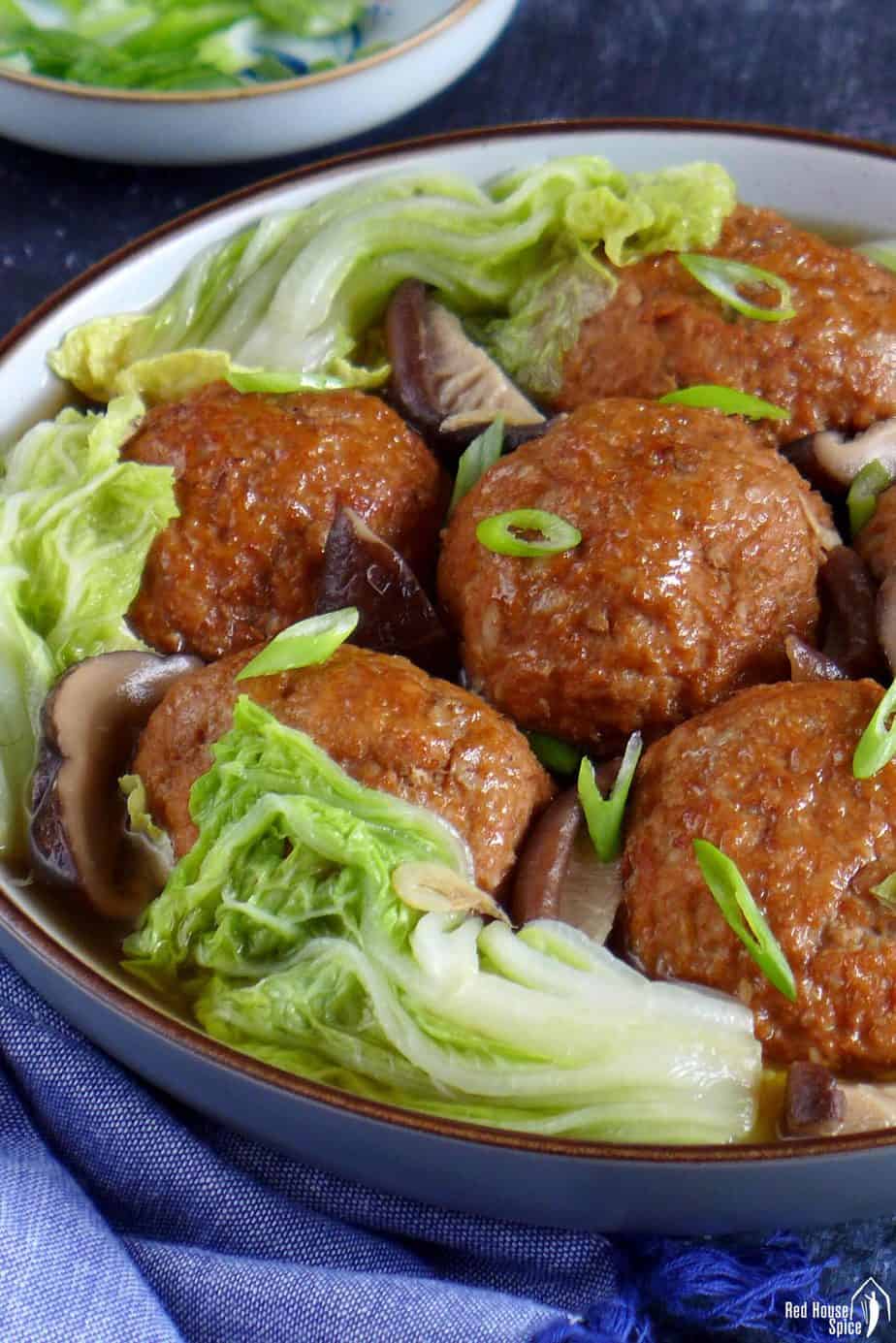
Lion’s Head Meatballs, A Classic Banquet Dish
The Chinese name for this dish is simply Lion’s Head (Shī Zī Toú/狮子头) without mentioning meatballs. You might be wondering why it’s given such an unusual name. According to Chinese food historian and cookbook author Yan-kit So, when the dish is served, the meatball, which is the size of a tennis ball, resembles a lion’s head, and the cabbage its mane.
A signature dish of Huaiyang cuisine (淮扬菜), lion’s head meatballs routinely appear at banquet-style meals. Despite its high culinary status, it’s easy to make it in home kitchens. It takes more time and effort than cooking a quick stir-fry. Nevertheless, you don’t need sophisticated skills to make it to a high standard.

There are a few popular ways to cook/present this dish. The meatballs can be either deep-fried, steamed or cooked in water (same as the method I introduced in the post for Winter Melon & Meatball Soup). You’d see them served either in a clear broth with Napa cabbage or with a soy sauce-based thick sauce. For today’s recipe, I’ve chosen to combine deep-fried meatballs with Napa cabbage and a mushroom-flavoured clear soup.
The Summary of the Cooking Procedure
I break down the cooking procedure into three parts. Before we get into the detailed cooking tips, let’s first have a look at what to expect at each step.
- Prepare a tasty meatball mixture that’s well seasoned and stirred to a sticky, jiggly texture. This will result in tender, moist meatballs in the finished dish.
- Divided the mixture into equal portions. Use the aide of a small bowl to shape one portion into a ball then deep fry until golden. Repeat the procedure to finish the rest.
- Use the water in which dried shiitake mushroom is rehydrated to simmer the fried meatballs, Napa cabbage, mushroom, etc. with light seasonings.
Prepare a Moist Meatball Mixture
For lion’s head meatballs, preparing a good minced meat mixture is the key to success. It has to be well-seasoned, tender, moist yet holds in shape very well. Read on to learn the tips and tricks!
What goes into the mixture?
- Minced pork. Chinese professional chefs always use hand-chopped pork for this dish (many devoted home cooks follow this tradition too). It’s believed that manual mincing creates a better texture. I encourage you to try this method if time permits. That said, I’ve experimented with shop-bought minced pork and the end result is quite good as long as the fat content is 20% or higher.

- Minced chicken. This is my personal addition which doesn’t usually appear in traditional recipes. It adds more umami flavour and enhances the stickiness of the mixture (making meatball shaping a little easier).
- Classic seasonings for minced meat including Shaoxing rice wine, light soy sauce, sesame oil, salt & sugar. If for dietary reasons you can’t use Shaoxing rice wine, please feel free to skip it.
- Water flavoured with scallions & ginger. Soak scallions and ginger in warm water to release their aroma. Add the water little by little to the meat while stirring.
- Egg & cornstarch. These two ingredients increase the stickiness of the mixture, as well as enhance the tenderness of the meatballs.
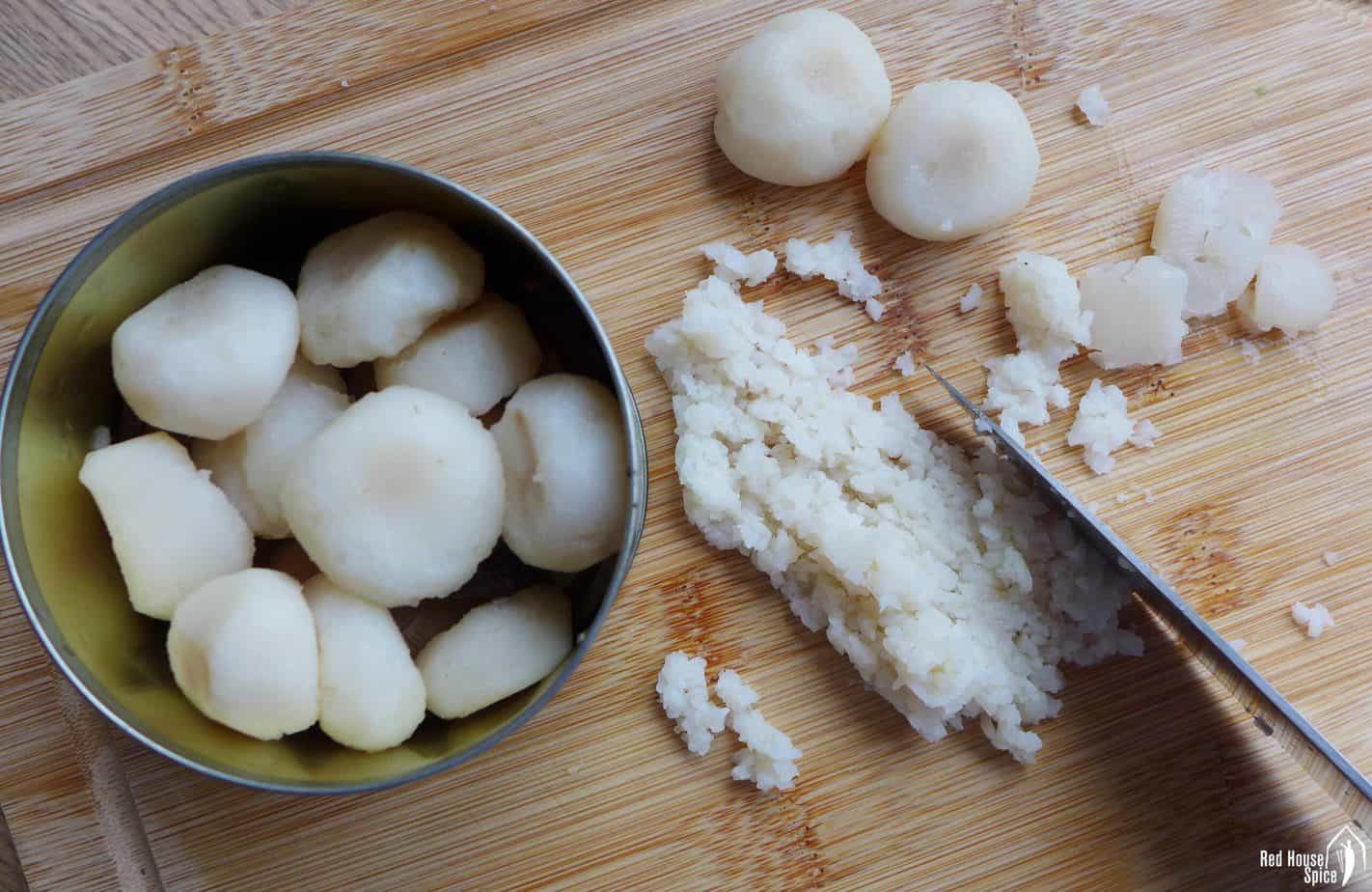
- Water chestnut. Known as Bí Qì (荸荠) in Chinese, it’s the corms of an aquatic vegetable. Essential to lion’s head meatballs, it adds a crunchy texture (and a hint of sweetness) to the soft meatballs which I find very pleasant on the palate. Finding fresh water chestnut might be challenging, but the canned ones (see image above) are widely available in Chinese stores. I highly recommend you make an effort to source it.
How to stir & combine
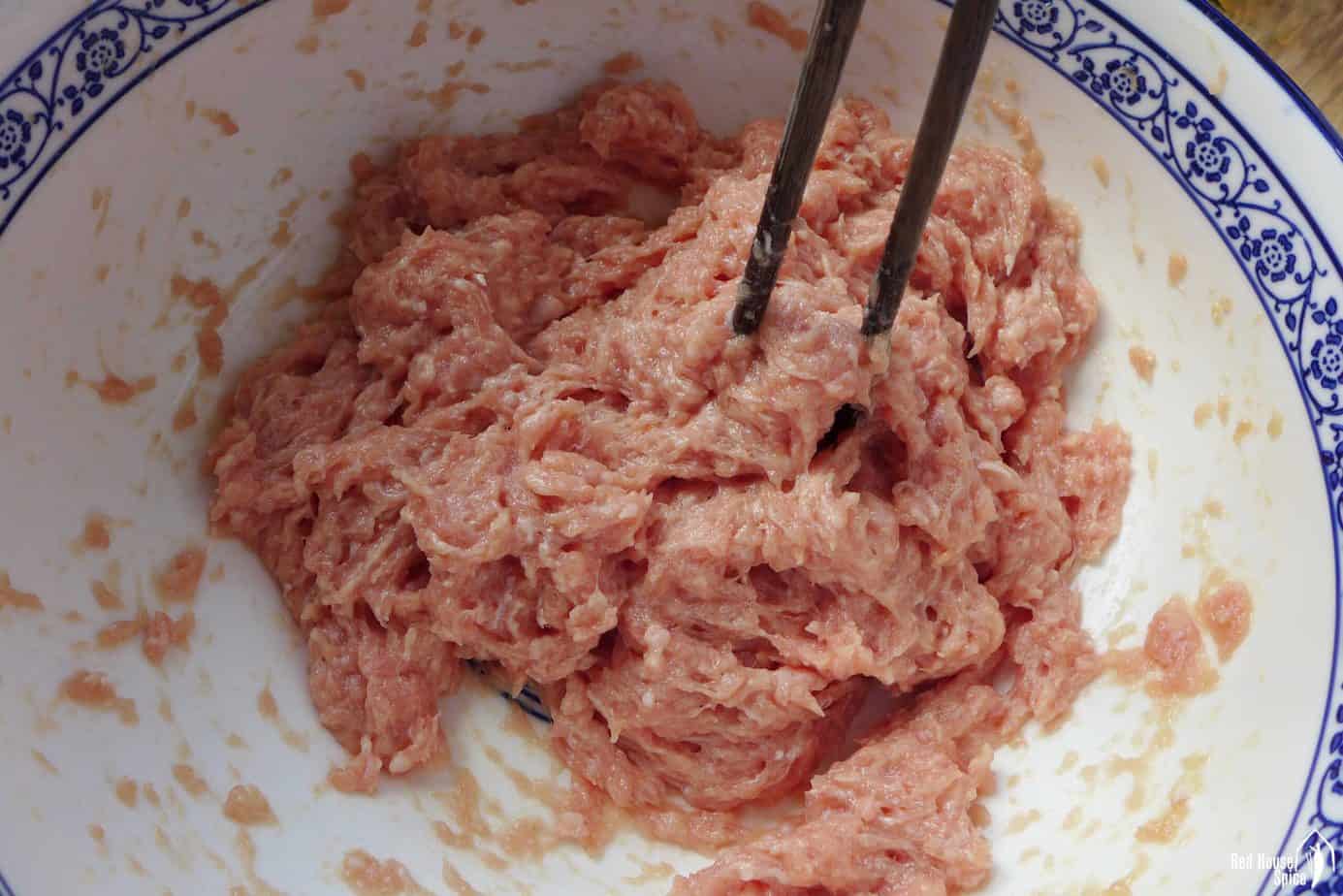
As you can see from the ingredient list above, there is quite a bit of liquid, which helps to achieve a tender and moist texture, goes into the minced meat. So it’s critical to stir well to let the meat fully absorb the liquid.
When it comes to mixing minced meat, Chinese chefs always emphasize the importance of stirring in one direction constantly. It’s believed that this helps the fibre of the meat to line up. The well-combined mixture should look sticky, smooth and a little jiggly (due to the high water content). It forms a ball shape easily and doesn’t fall apart while handling or frying.
Shape & Fry the Meatballs
The next step involves shaping the mixture into big balls then deep frying them until golden. You might come across recipes suggesting having all the meatballs formed before frying. I prefer another workflow: Shape one ball then put into the oil to fry. While waiting, make another ball. I think it’s less time consuming this way.
How to shape meatballs neatly
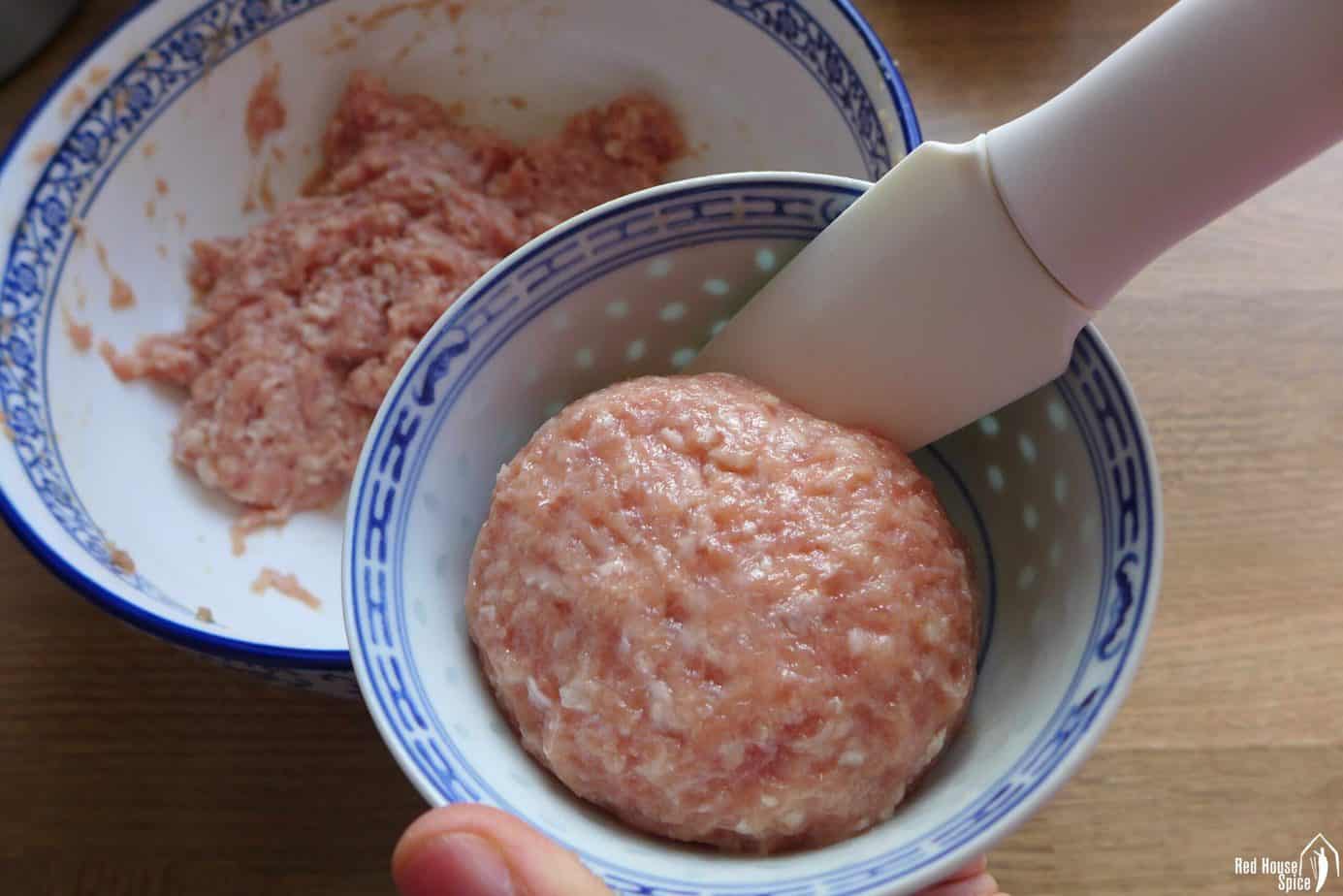
Lion’s head meatballs usually measure 6-7 cm in diameter (like the size of a tennis ball). For this recipe, I divide the meat mixture into six portions to form six balls (Do you know six is a lucky number in Chinese culture). If you’d like them smaller, make eight instead.
The way I shape lion’s head meatballs isn’t ’traditional. Instead of my hands, I use a small bowl to help. Scoop one portion of the mixture and put into the bowl. Use a spatular or a spoon to gently press the meat against the bowl while turning the bowl little by little. Keep doing it until a smooth, round ball appears (Please refer to the video tutorial in the recipe card below). Isn’t this a neat and efficient way to accomplish the task?
How to deep fry the balls
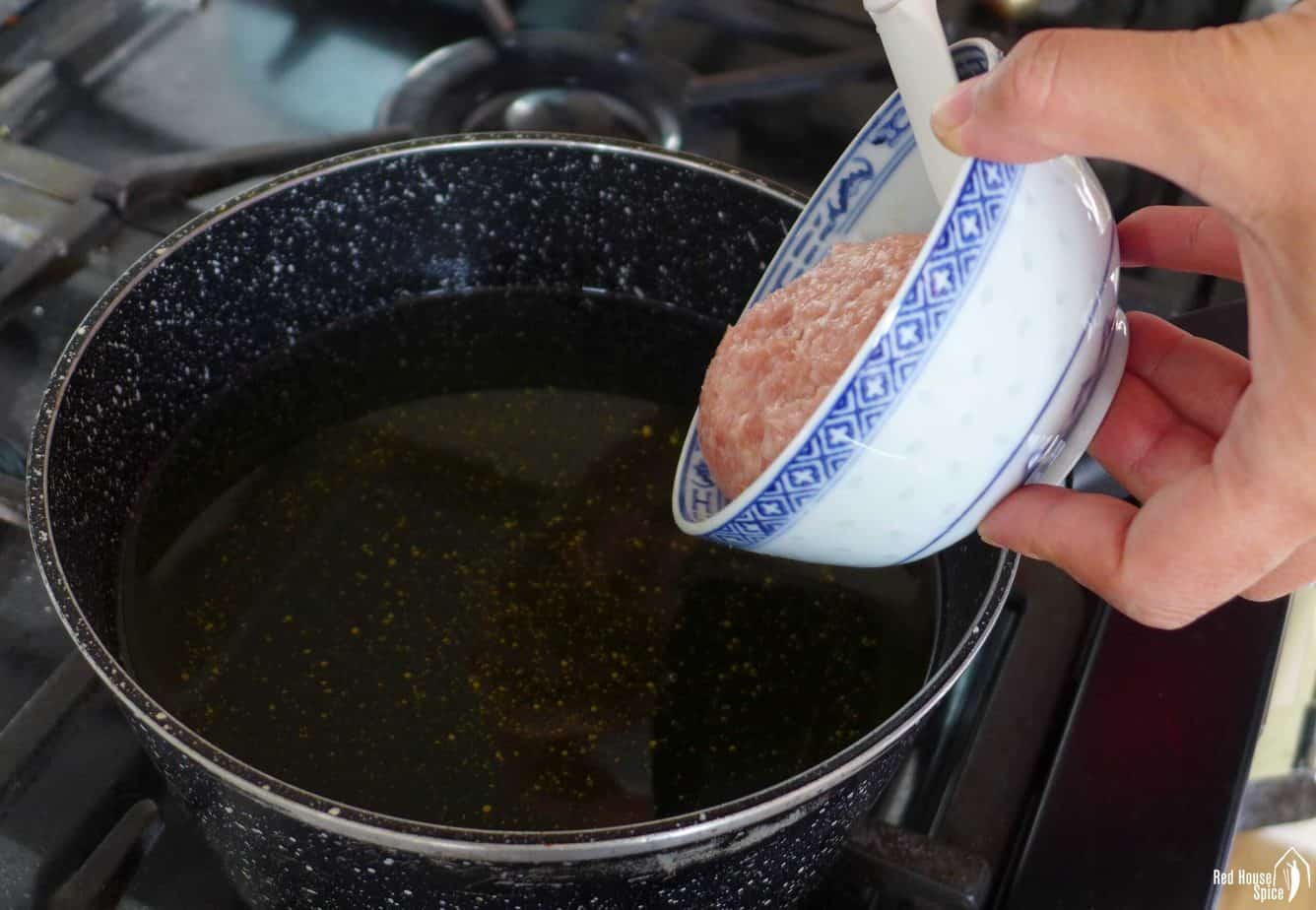
The amount of oil required for deep frying depends on the size of your cookware. To save oil, I suggest you use a small deep pot. For a 20cm/8inch one like mine, you would need 800ml, about 3.5 cups. Make sure your oil has a high smoking point thus is suitable for deep drying. Neutral flavoured oil, such as sunflower, rapeseed, vegetable, are good choices.
Place the pot on a burner over medium-high heat. Once the temperature reaches 180°C/360°F, you’re ready to slide in the meatball. If you don’t have a kitchen thermometer, use a chopstick to test. Dip the tip into the oil. If small bubbles immediately appear around the chopstick, the temperature is high enough to start frying.
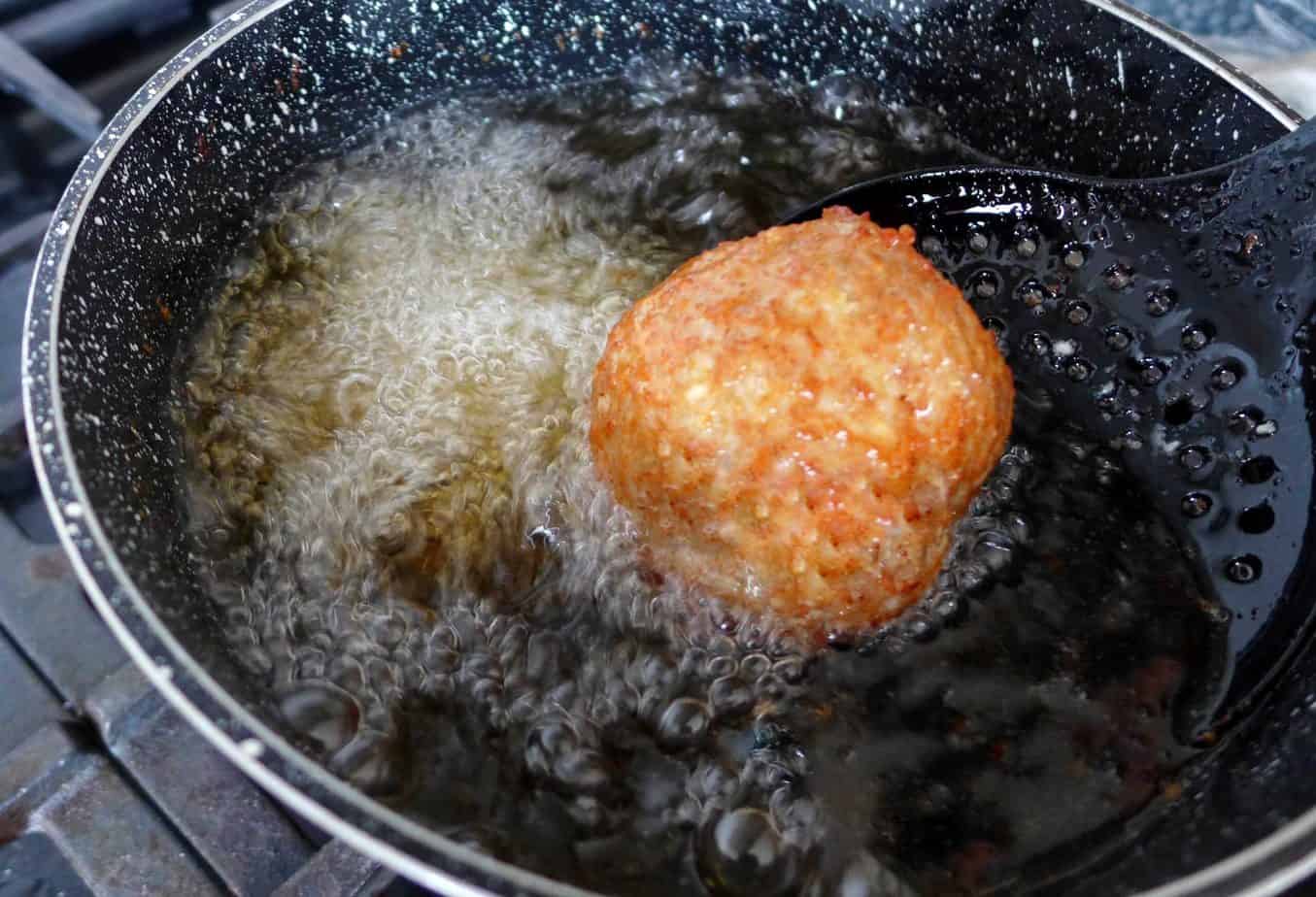
Since the meatballs are quite large, be extra careful when sliding them into the hot oil to avoid splashing. Do not fry more than two balls at a time as you don’t want the oil temperature to drop too much. Also, the meatballs need ample space to move around in the oil.
Gently move the meatball from time to time for even browning. Once they become golden all around, transfer to a plate lined with kitchen paper (for absorbing excess oil).
Cook the Meatballs in a Soup
The last step is to simmer the meatballs in a fragrant broth along with Napa cabbage and mushroom. This procedure helps to further tenderise the meatballs. The addition of vegetables makes the dish less greasy but more nutritionally balanced. Here are what you need:

- Napa cabbage. Oftentimes in our Red House, Napa cabbage in this dish disappears faster than the meatballs. It absorbs all the flavours from other ingredients yet tastes very light. I cut its leaves into halves and place the white, crunchy part underneath the meatballs to simmer. The green/yellow leafy part is laid over the meatballs during the last 5 minutes of cooking (since it takes much less time to cook it to desired texture).
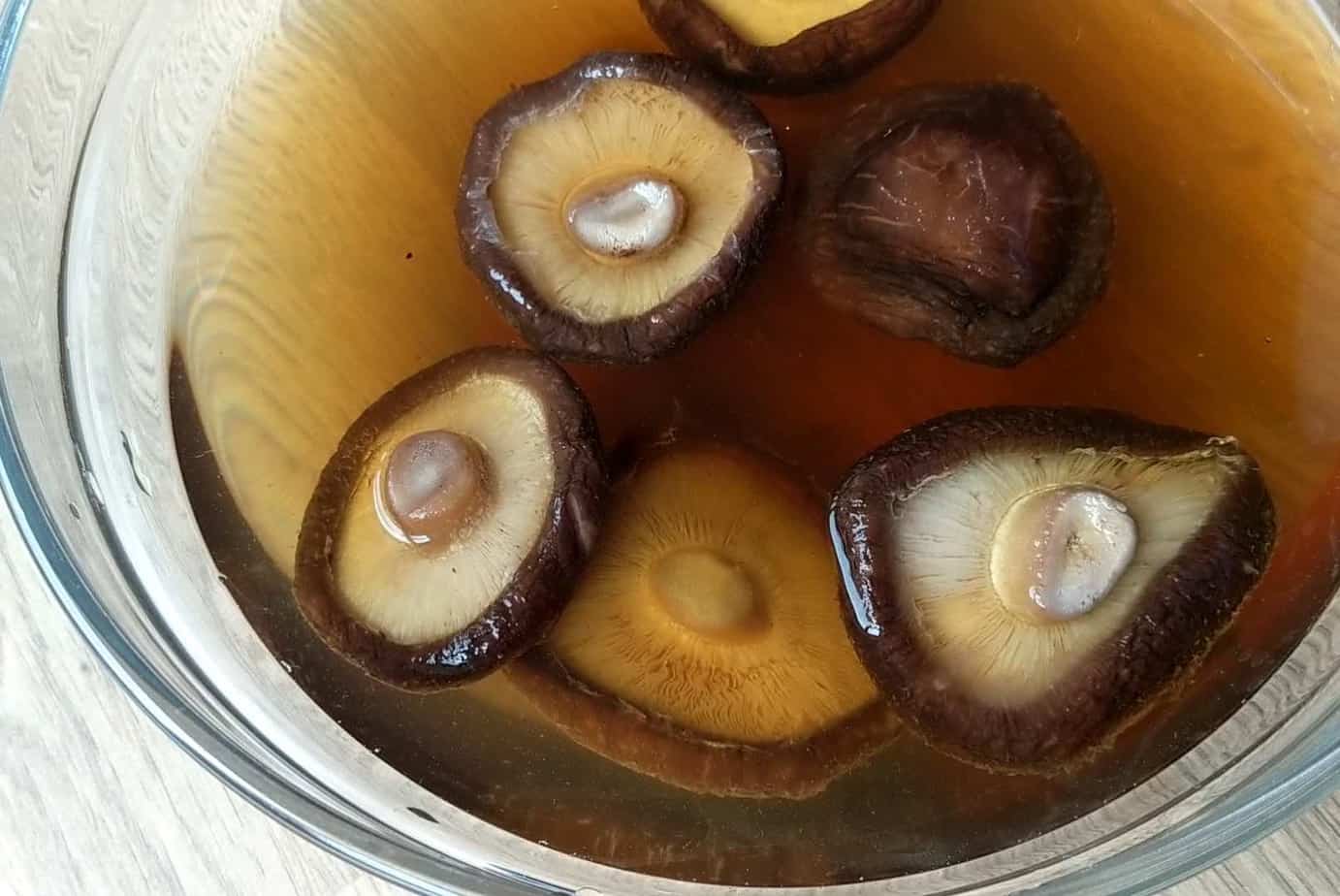
- Dried shiitake mushroom. Unlike Napa cabbage, shiitake mushroom isn’t an essential ingredient in traditional recipes for lion’s head meatballs. However, I think it can be a key factor for elevating the taste level of this dish if you use it the way I suggest: Choose dried ones instead of fresh ones as the former creates a much richer flavour. Don’t discard the water in which you rehydrate the mushroom. Use it to replace water for the soup. Believe me! It makes a great difference.

- Dried shrimp. This is an ingredient that I adore in soup dishes. You can find it in my recipes for Tomato Egg Drop Soup, Tofu & Vegetable Soup, etc. No exception this time. You may use either regular dried shrimp or papery dried shrimp which are much smaller. Although I marked it as optional in the recipe, I highly recommend you get some whenever you have a chance.
- Scallion & ginger. Remember that we’ve soaked some scallions and ginger in water when making the meatball mixture. Now add them to the soup so nothing is wasted.

First, bring the water to a full boil. Then turn the heat down to the lowest and leave to simmer. After about 15 minutes, lay the leafy parts of the Napa cabbage over the meatballs. Cook for a further 5 minutes. Garnish with finely chopped scallions then serve!

What to Serve with Lion’s Head Meatballs
As a sophisticated centrepiece, lion’s head meatballs are usually enjoyed with other savoury dishes and steamed rice as a staple. I’d like to share an example of what to pair with it in an authentic Chinese meal for 6-8 persons.
- Chinese Cucumber Salad, a refreshing appetiser that can be made in three ways.
- Beef Shank Appetiser is a classic cold dish that wakes up all your taste buds.
- Steamed Whole Fish is a must-have for festival dinners as it’s believed to bring good luck and fortune.
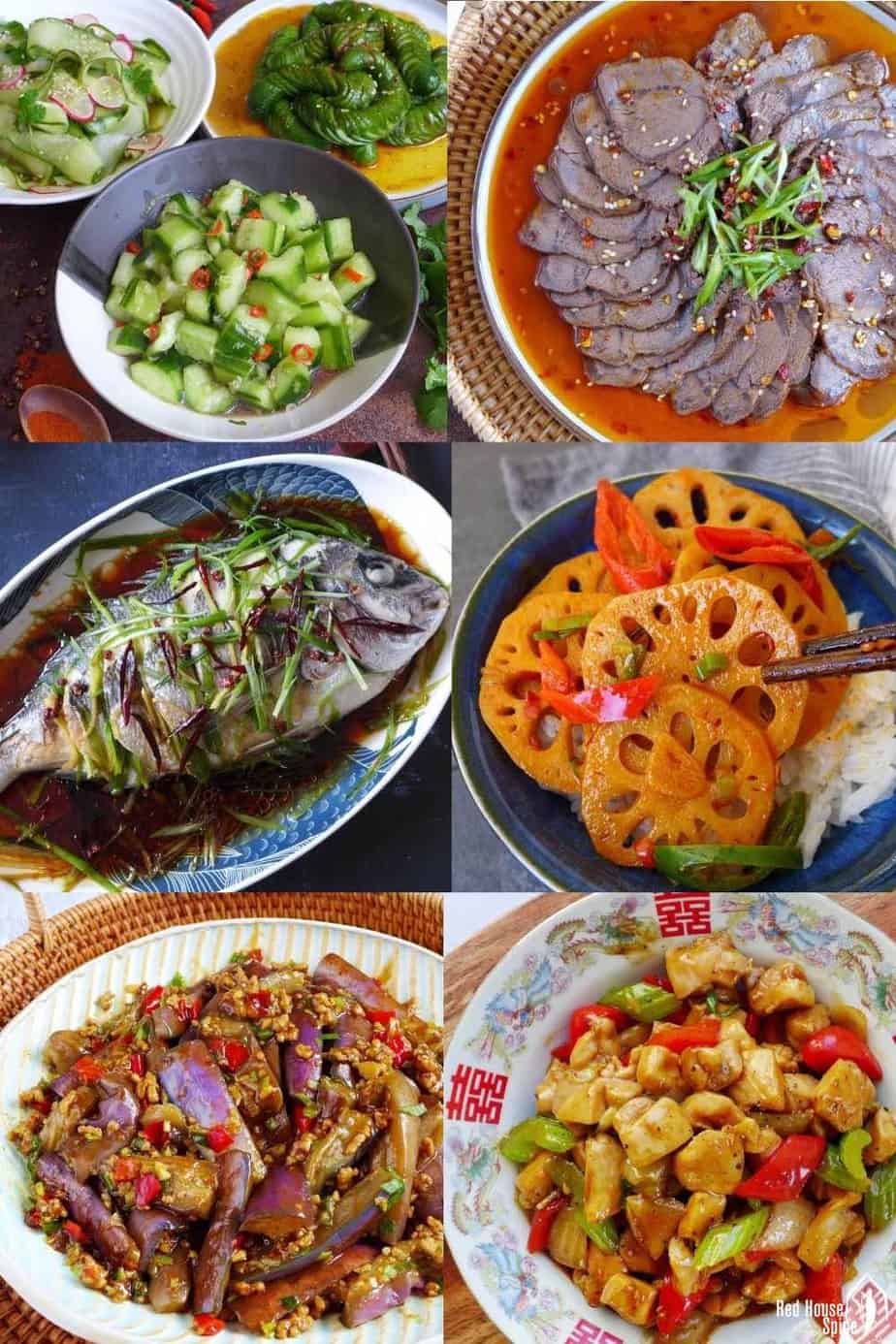
- Black Pepper Chicken, a quick stir-fry dish loved for its succulency and tasty, shiny sauce.
- Lotus Root Stir-fry, a vegan dish featuring a great combination of crunchy vegetable and chili bean paste.
- Eggplant with Garlic Sauce, a signature Sichuan dish packed with fragrant flavours.
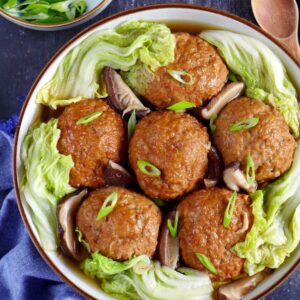
Lion’s Head Meatballs (狮子头)
Ingredients
For the meatballs
- 2 stalks scallions
- 1 thumb-sized ginger
- 400 g minced pork, with 20% fat or higher - see note 1
- 100 g minced chicken
- 2 tablespoon Shaoxing rice wine
- 2 tablespoon light soy sauce
- ½ teaspoon salt
- ½ teaspoon sugar
- ½ teaspoon sesame oil
- 1 large egg
- 1 tablespoon cornstarch
- 60 g water chestnut, minced - about 10 canned ones
- Cooking oil for deep frying - see note 2
For the soup
- 7 pieces Napa cabbage leaves, cut in halves crosswise
- 6 large dried shiitake mushroom, soaked in 500ml water overnight
- ½ tablespoon dried shrimp - optional
- ¼ teaspoon salt, or to taste
- 1 pinch ground white pepper
Instructions
Prepare the meatball mixture
- Cut the scallions into sections (save some green parts for garnishing the dish later) and slice the ginger. Soak them in 6 tablespoon of warm water. Leave to cool.
- In a bowl, mix minced pork, minced chicken, Shaoxing rice wine, light soy sauce, salt, sugar, sesame oil, egg and cornstarch. Stir constantly in one direction while adding the scallion ginger water little by little.
- Once the liquid is fully absorbed and the meat becomes sticky and jiggly, add minced water chestnut then stir to combine.
Shape & fry the meatballs
- In a deep pot, heat up oil for deep frying (A smaller pot requires less oil).
- Divide the meat mixture into 6 portions. Transfer one portion to a small bowl. Use a spatular or a spoon to press the meat against the bowl to shape it into a ball (please refer to the video below).
- When the temperature of the oil reaches 180°C/360°F (see note 4 if you don’t have a kitchen thermometer), gently slide the meatball into the oil (be careful not to splash). Roll it from time to time to ensure even colouring. Take out when they look golden all around.
- Repeat the procedure to shape and fry the rest of the balls. Since these meatballs are quite large (about 7cm/2.7in), do not fry more than 2 balls at a time as you don’t want the oil temperature to drop too much. Also, the meatballs need ample space to move around in the oil.
Cook the soup
- In another pot, lay the white part of the Napa cabbage then place the fried meatballs on top.
- Add sliced shiitake mushrooms and pour in the water in which the mushrooms were soaked (discard the solid bits at the bottom of the bowl).
- Add the scallions & ginger (which were used to flavour the water used in the meat mixture) and dried shrimp (if using). Season with salt and white pepper.
- Bring the soup to a full boil. Turn the heat to low. Cover with a lid and leave to simmer for 15 mins. Put the remaining leafy part of the cabbage over the meatballs. Continue simmering for a further 5 mins.
- Garnish with finely chopped scallions. Serve warm with plain rice, along with other savoury dishes.
Video
NOTES
NUTRITION
NUTRITION DISCLOSURE: Nutritional information on this website is provided as a courtesy to readers. It should be considered estimates. Please use your own brand nutritional values or your preferred nutrition calculator to double check against our estimates.



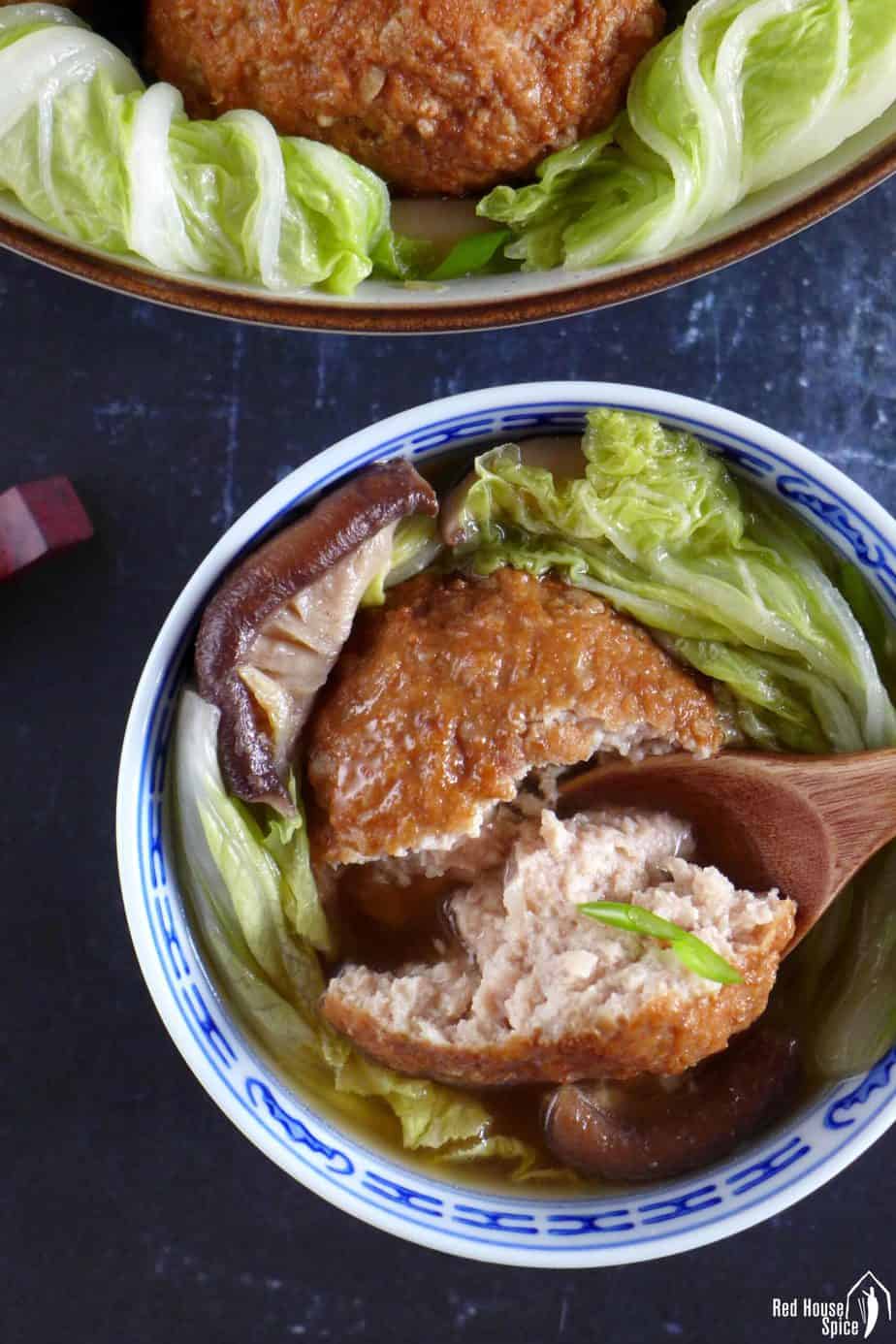
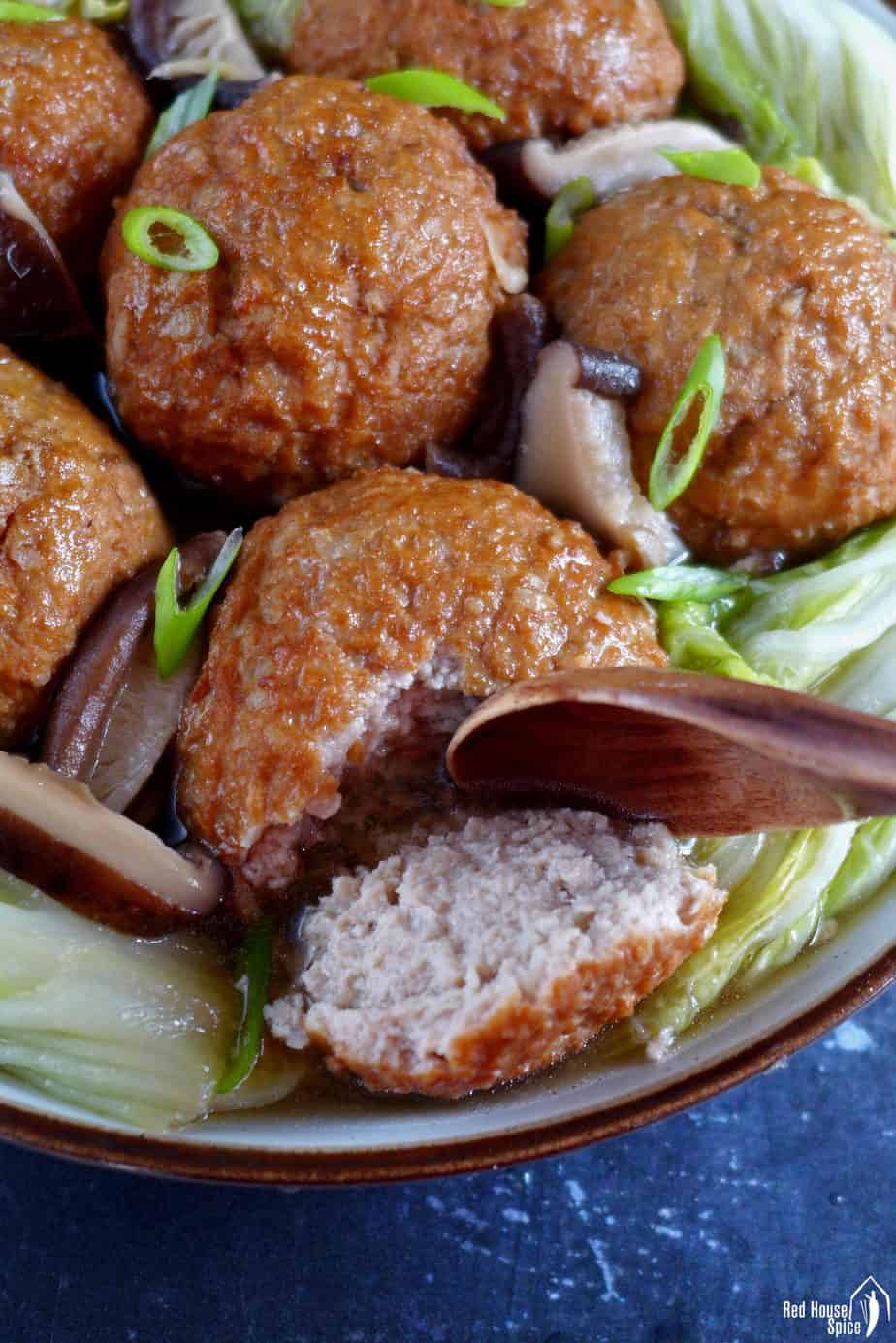
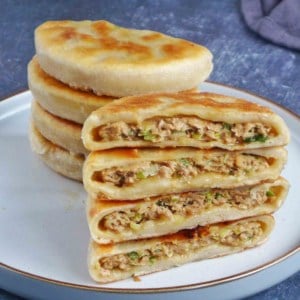
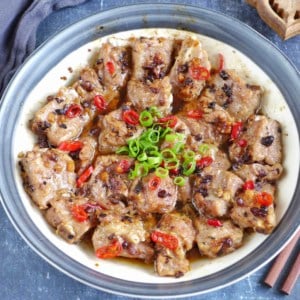

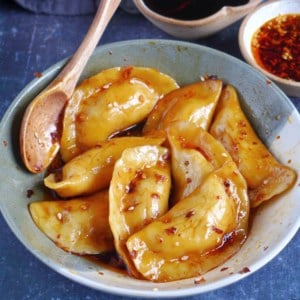
I’m a pretty basic white girl (lol) with a son adopted from China so when we had friends over to celebrate lunar new year I wanted to serve them something authentic alongside our beloved Panda Express. I chose this recipe since it would be easy to prepare the day before. It was absolutely delicious!! I struggle to find the Ingredients I’m looking for when I go to the Chinese grocery so I settled on fresh oyster mushrooms and chicken broth in lieu of soaking the dried mushrooms. It still was extremely tasty. Thank you for your blog and the lovely recipes. Nothing makes my son happier than a plate of real Chinese cooking… especially if it contains cabbage in any form!
What a heartwarming story! I’m so happy to hear you’ve created a special bond with you son through Chinese food. I completely understand his affection for cabbage. I feel the same way!
I made this recipe last Chinese New Year and I LOVED IT!! Thank you for your wonderful recipe!
Is there any way I can pre cook the meatballs or the entire dish and serve the next day? I’m preparing the CNY menu for my family and it’s so much work 😅
You can deep fry the meatballs in advance and cook the soup on the day. This is exactly how I prepare this dish for big feast. Wish you a lovely celebration and a wonderful Year of the Dragon!
I am cooking them right now. Instead of frying I am trying the lion’s heads in the airfrier.
I know the soup will look and taste delicious.
I will check out your other recipes. Living far from the city I have ti satisfy my cravings😂
Thank you!!!🩷
Yes, air-frying is a healthier alternative. Hope you enjoyed the dish Cristina!
Second time trying this and the flavour’s fantastic! We devoured them so didn’t get a picture until too late, this time I took one after the initial fry. We don’t mind the shape much and care more about wasting a bunch of oil from deep frying, so we shallow fry. Subsequent shape aside it’s almost the same as what we have back home in China! Thank you so much for the recipe!
How wonderful to hear that! Yes, it doesn’t matter how it looks as long as the taste is spot on. So happy to know you enjoyed the dish Ming!
This is the second time I’ve made lion’s head and it’s sooo delish!! I think this is one of my favorites to make from Red House Spice (my other faves are steamed fish, I use fresh snapper; and the braised pork belly). Because there is no specific Asian market where I live (it’s about 60 or more miles away), rather than using Shaoxing rice wine I used mirin. And rather than mincing my own meat, I used fresh locally raised healthy ground pork, 100% meat no fillers; I let the excess blood and liquid drain in a strainer and then pushed the meat to squeeze out more liquid before adding the condiments. It was still delicious with those tweaks. I’m taking an interest in Chinese food because I love Asian food in general and myself am ethnically part Chinese and love learning about culture through cuisine.
Made it twice in two days’ time – it’s mad how good it is. My wife loves it, I love it, even cats love it (the five-second rule does not apply in the household with two-second cats).
Once you have all the ingredients, the recipe is easy to follow. Good tip about the small bowl – I hate sticky hands.
So happy that you’ve enjoyed my recipe Matt!
Thank you for this lovely recipe.
As I try to minimize deep frying, how do I tweak the recipe to boil or steam the meatballs instead?
Thanks!
Yes, you can steamed them instead then follow the same procedure to cook the soup with cabbage, etc. Happy cooking!
Thank you so much for this recipe, Wei. I can’t wait to try it.
My pleasure Michael! Hope you’ll like it.